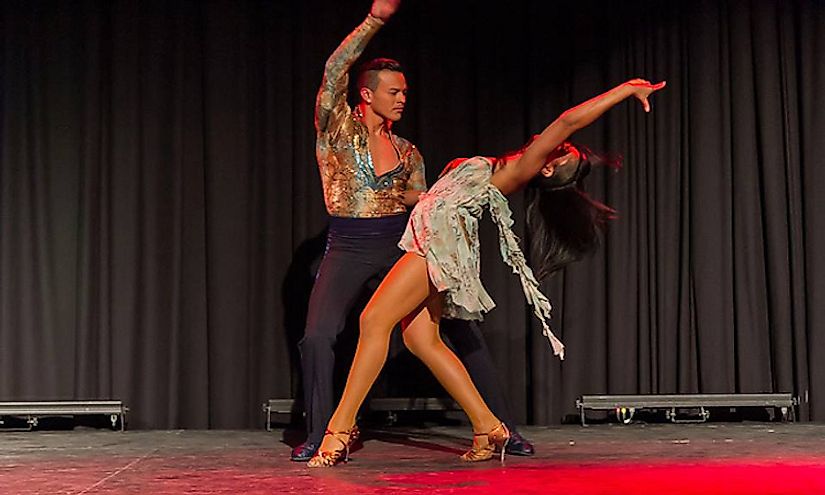The Dance San Francisco Diaries
Table of ContentsUnknown Facts About Dance San FranciscoAn Unbiased View of Dance San FranciscoThe 5-Second Trick For Dance San FranciscoThe Buzz on Dance San Francisco
Allow's consider Salsa dance and music as a large Tree that resembles this: Salsa is danced globally while many technical aspects of the dance are the exact same throughout styles (6 steps over 8 beats danced on a quick-quick-slow or slow-quick-quick rhythm), there are several "characteristic" functions of the primary designs of Salsa that identify one from the other.Couples getting involved in a Gambling enterprise Rueda dance all steps in unison as called by a Leader. Distinguishing functions of Cuban design salsa are round turn patterns (with "break back" steps on matters 1 and 5) along with body motion motivated by standard Afro-Cuban folkloric dances. Distinct functions of Cali style salsa is fast and detailed footwork, danced with a solid hand hold link between partners.
The beginnings of the design are a subject of argument, but it is claimed that New york city design Salsa dancing originated in the 1960's due to the increase of Latin American emigrants after the Cuban Revolution (salsa dancing sf). Eddie Torres is the most well understood New York style professional dancer, being nearly generally attributed with popularizing the style to dance centres beyond New york city
The basic rhythm of "On-2" is slow-quick-quick. The "youngest" of the designs of Salsa, L.A (https://www.storeboard.com/dancesanfrancisco). Design (some individuals have called it "West Coast" design) became popular in the 1990's and has its origins in ballroom (Mambo, Swing and Cha, Cha, Cha). Turn patterns lead and comply with methods are heavily influenced by these designs, with the Cross Body Lead being the cornerstone of the design
All About Dance San Francisco
Design are implementation of turn patterns and numbers in the "port", with the break steps on matters "1" and "5". While Salsa music has solid beginnings in Cuban, Colombian and Puerto-Rican folkoric traditions, it can not be discounted that all Afro-Latin and Latin American cultures have actually contributed to contemporary Salsa songs as we understand it today.

There she came to be buddies with the Nuyorican artists, and her collaborations with them and her time with the Fania All-Stars resulted in over 50 albums (of collective and solo work). Many thanks to the internet and ease of accessibility to details, the appeal of Salsa music, dancing and society has actually spread like wildfire over the last 30 years and even then contemporary Salsa musicians remain to pay homage to the Starting Dads and Mom of Salsa.

The Definitive Guide to Dance San Francisco
distinguishing attributes of Salsa songs are: 4/4 measure signature, Kid Clave and Tumbao rhythms, Montuno Piano Unless you have a background in music, the above 3 attributes most likely mean nothing to you. A less complicated method to describe Salsa songs is just how it does NOT seem like other sorts of Latin American music.

It's time for lessons. With numerous workshops around and different styles to pick from, where does a complete novice begin? Many all new professional dancers pick to learn L.A. "On-1" design slotted Salsa designs are the most widespread in North America (with some exemptions of some urban centres that still primarily embrace Cuban and Puerto Rican styles) and L.A.
.A. Style will promptly show you the principles of Salsa timing, weight transfer and turn pattern implementation. Lots of dancers, as soon as they've had a year or 2 of dance L.A. Style Salsa under their belts, "switch" to New York style in order to expand their dancing vocabulary; however lots of professional dancers determine to adhere to just one design of Salsa and appreciate their time on the dance flooring because specific style. salsa dancing sf.
Design and New York Style all being danced in the same club, with a lot of the professional dancers having the ability to change from one style to the other from one track to the following. salsa dancing sf. Despite which style you pick it is essential to adhere to that style until you're really comfy with the basics of timing, body rhythm and foundation move implementation prior to thinking about "changing" designs (if you intend to)
As soon as you begin on lessons prepare to commit energy and time to discovering how to continue reading this dance in basic it takes a total beginner (i. e., someone with little or no dancing experience) regarding 6 months of actively taking lessons and going out and practicing at the very least two times a week to obtain to a point where pattern implementation starts to feel "natural".